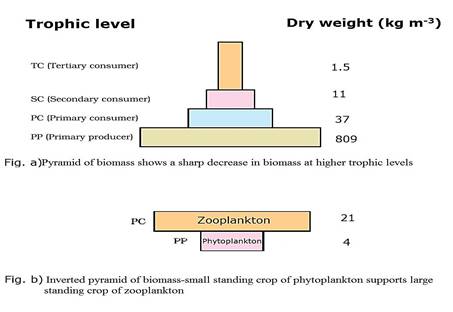a) Study the flow chart given below and complete the equation that follows by identifying 1, 2, 3 and 4.

(b) Mention the different ways by which the population density of different species can be measured.
OR
(a) ‘The pyramid of energy is always upright.’ Explain.
(b) Explain with the help of labelled diagrams, the difference between an upright pyramid of biomass and an inverted pyramid of biomass.
a) Nt+1 = Nt + [(B + I) – (D + E)]
b) Three ways to measuring population density of a habitat
i) Per cent cover or biomass for a tree with larger canopy
ii) The number of fishes caught per trap
iii) Pug marks and fecal pellets for tiger census
OR
a)
• Pyramid of energy can never be inverted, is always upright because some energy is always lost as heat at each step when energy flows from a particular trophic level to the next trophic level.
• Energy at a lower trophic level is always more than at a higher level.
• Transfer of energy follows 10 % law of energy transfer in which only 10 % of the energy is transferred to each trophic level from the lower trophic level and the amount of energy decreases at each successive trophic level.
• For their energy demands, organisms at each trophic level depend on those at the lower trophic level.
b)

• Upright pyramid of biomass can be found in forest and grassland ecosystems, while the invented pyramid of biomass is seen in lake and ocean ecosystem as the biomass on the next trophic level is higher than the previous trophic level in an inverted pyramid.